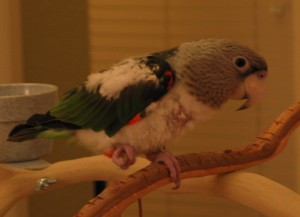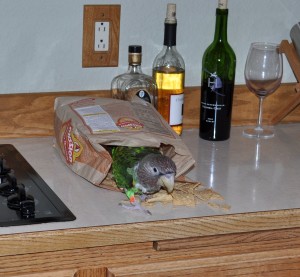Birds in flight are the very symbol of liberty. Yet what do people do to the most sentient, socially and intellectually evolved among them? We cage them and maim them by clipping their wing feathers.
And what a heart has Dr. Steve Boyes!
He has dedicated himself to reversing the destruction humans have wrought on the Cape Parrot. What a heroic commitment he and his team (including Cape communicator Rodnick Biljon, who captures the Cape Parrot on film) have pledged to rescuing the Cape Parrot from extinction, brought about by the decimation of the Yellowood forests of the Eastern Cape. (Your host hails from Cape Town.)
The Cape Parrot Project is one of my favored charities. Owned as I am by an Un-Cape Parrot (a genetic relative to the wild Cape Parrot), I’ve had the privilege of experiencing first-hand the intense brilliance of these precious Pois (mine is Poicephalus fuscicollis; the Cape Parrot is Poicephalus robustus). We rescued Oscar-Wood from a cage in a store, where he had languished for 4 years, plucking his feathers down to the pink skin beneath. This, after having been sold into the trade by a well-known breeder in Hawaii.
LOOK at him then (2009):
Another heartbreaking image (2009):
Here Oscar-Wood is today (2012), fully flighted, nesting in a bag of tortillas. This state of relative well-being has come about only because I work from home and am able to give him the attention and freedom he requires to thrive. And still he plucks; once acquired, this neurotic habit is hard to eliminate.
Oscar-Wood has a facility with … wood (all parrots require wood, preferably from a tree, in the wild):
WARNING. Do not try the above at home. By all means, rescue an abandoned and abused parrot, but do not fuel the wicked pet parrot trade, which everywhere and always involves breeding mills, inhumane by definition. As to wild-life traffickingg … words fail.
Those who’ve bothered to get to know a parrot in flight, if hobbled horribly by the walls of a house (the Cape, for example, can fly hundreds of kilometers in a day), know this: Out of a cage, free to be adorable and impossible as only hookbills are—parrots are so much smarter than any of the domesticated animals (and than some of your neighbors).
Even showmen such as parrot whisperer Clint Carvalho attests that the larger parrots are “twenty times smarter than dogs.” I’m not sure how Carvalho quantifies his findings, but these sound about right.
Know a politician with this magic macaw’s problem-solving skills? Tan’s Japanese admirers are enthralled. As well they should be. Watch Tan solve an impossible magic-cube like puzzle:
What’s positive about Carvalho is that, unlike your average avian dabbler, he has realized that parrots acquire rudimentary language (often greater than those acquired by the bumper crops of illiterates US public schools produce) through conditioning and cognition, just as kids do.
The cognitive capacities of the parrot, however, match his emotional needs.
Unlike dogs and cats, birds are wild animals, ill-suited to captivity. Moreover, they’re flock animals who wither without the physical proximity of a feathered family with which they fly, forage, communicate and mate, often for life.
The trade is fueled by consumer demand.
Being slaves to authority and convention, the mass of humanity doesn’t much like or appreciate the independent-minded individuals among them. Imagine the fate of a creature as smart, as independent-minded and as individualistic as the parrot?
Consider the cruelty of excluding parrots from assorted public-awareness campaigns. Funds are invariably solicited for and awareness raised over the airwaves about abused and needy dogs and cats. Not so for parrots. Despite their popularity as pets and their prevalence in American homes, natural disasters come and go without any mention of the plight of the Psittacine victims.
Coveted. “Consumed.” Discarded.
That is the fate of parrots bred for the pet trade. Break the cycle. Adopt a neglected and abused animal from a shelter. Support your community based shelters.
AND donate to save the Cape Parrot.
Writes Dr. Boyes:
Most people know about the popular African Grey parrots of central and western Africa, but very few people know about Africa’s most endangered parrot, South Africa’s Cape parrot. Today, there could be as few as 800 Cape parrots remaining in the wild and they are considered Critically Endangered due to continued habitat loss, poor nesting success due to lack of nest cavities, a severe Psittacine Beak and Feather Disease epidemic, historical persecution as a crop pest, and illegal capture for the wild-caught bird trade. If Africa was to lose this “green and gold” ambassador of some of our last-remaining Afromontane forest patches, it would be a sign of very bad times to come… We would have lost one of the last Afromontane endemics clinging onto these forests through their own ingenuity and collective intelligence. Intensive logging in their forest habitat, persecution (e.g. being shot or caught in nets and clubbed to death), nest poaching and mist-netting adults for the wild-caught bird trade, and very little or no conservation intervention, has left the Cape Parrot in ruins with an aging populations in declining physical condition. We need to intervene now and stimulate positive change for Cape parrots in the wild
UPDATE (3/25): Following the Facebook thread.
JP: Point taken, but parrot are picky about friends and partners. The chances of a friendship being struck up are greater when the other parrot is of the same species. Personally, I recommend against taking on two parrots. That’s much like planning for one toddler and learning that you’ll be giving birth to twins. It’s never easier. Better that you be a good parront to one parrot than shortchange both and yourself. Of course, if you do not work, or your work is not too demanding (because parrots are), have a large enough house and homestead (maybe even place for an outdoor aviary)—by all means. Caring for parrots under the right conditions is rewarding. There is nothing like the love of a parrot, once earned.
Baby is currently doing lapse from his cage to kitchen cupboard (or what’s left of it; our kitchen has not been renovated and we’re delaying that job until we can think of how to parrot proof Sean’s planned maple-wood cabinetry).
Oscar-Wood is also talking up a storm. Singing his musical repertoire; knocking, and then demanding, “Hello, hello”; asking if I’m going, “Bye-bye-bye?” and if he’s been a “bad bird?” He’s also doing his raspy chest cough, because he knows the sound worries me. Should I dare to attempt to bathe him (parrots bath themselves pretty thoroughly), it’s an indignant, “Hey, hey!” Tell me that’s not a very decent attempt to communicate.


 print
print


